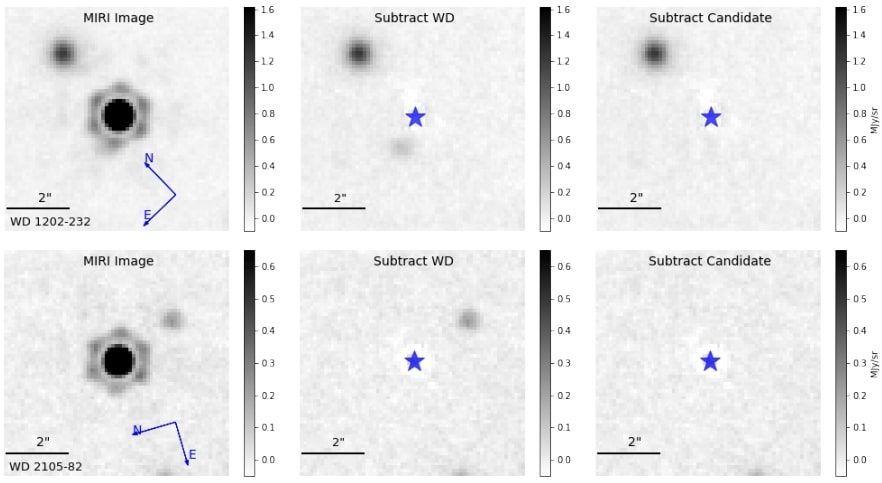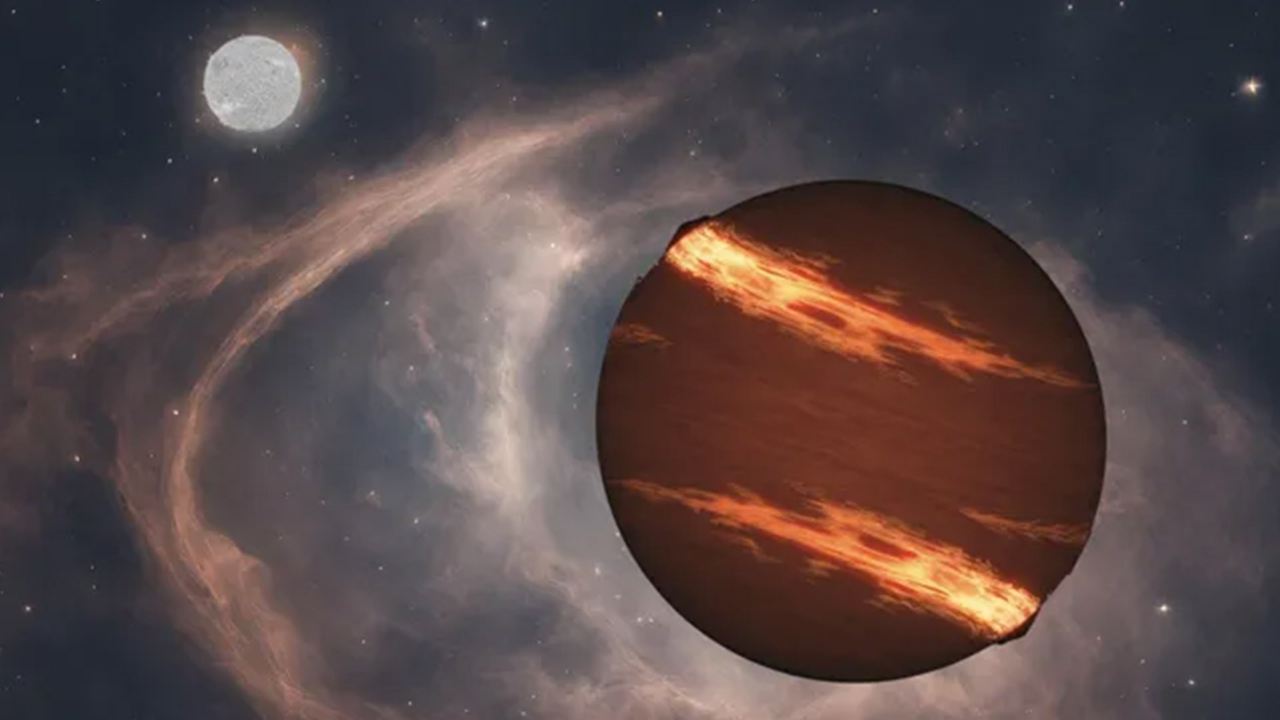In several billion years, our Sun will become a white dwarf. What will happen to Jupiter and Saturn when the Sun transitions to become a stellar remnant? Life could go on, though the giant planets will likely drift further away from the Sun.
Stars end their lives in different ways. Some meet their end as supernovae, cataclysmic explosions that destroy any orbiting planets and even sterilize planets light-years away. But only massive stars explode like that.
Our Sun is not massive enough to explode as a supernova. Instead, it’ll spend time as a red giant. The red giant phase occurs when a star runs out of hydrogen to feed fusion. It’s a complicated process that astronomers are still working hard to understand. But red giants shed layers of material into space that light up as planetary nebulae. Eventually, the red giant is no more, and only a tiny, yet extraordinarily dense, white dwarf resides in the middle of all the expelled material.
Researchers think that some white dwarfs have debris disks around them, out of which a new generation of planets can form. But researchers have also wondered if some planets can survive as stars transition from the main sequence to red giant to white dwarf.
Researchers at the Space Telescope Science Institute, Goddard Space Flight Center, and other institutions have found what seem to be two giant planets orbiting two white dwarfs in two different systems. Their research is titled “JWST Directly Images Giant Planet Candidates Around Two Metal-Polluted White Dwarf Stars,” and it’s in pre-print right now. The lead author is Susan Mullally, Deputy Project Scientist for JWST.
Theoretical thinking shows that exoplanets should exist around white dwarfs. Outer planets beyond where the asteroid belt is in our Solar System should survive their star’s transition from the main sequence to a red giant to a white dwarf. But stars inside this limit will be engulfed by the red giant as it expands. In our Solar System, the Sun will likely completely engulf or tidally disrupt and destroy Mercury, Venus, and Earth. Maybe even Mars.
Planets that survive this will likely drift further from the star since the star loses mass and its gravity weakens during the red giant phase.
But the problem is that it’s difficult to detect planets around white dwarfs. Despite pointed efforts, astronomers have only found a few planetary-mass objects orbiting white dwarfs.
As it stands now, Mullally and her colleagues have found two candidate planets around white dwarfs. They’re about 11.5 and 34.5 AU from their stars, which are 5.3 billion and 1.6 billion years old. If the planets are as old as the stars, then MIRI photometry shows that the planets are between 1 to 7 Jupiter masses. They could be false positives, but there’s only a 1 in 3,000 chance that that’s the case.
“If confirmed, these would be the first directly imaged planets that are similar in both age and separation
to the giant planets in our own solar system, and they would demonstrate that widely separated giant planets like Jupiter survive stellar evolution,” the authors write.
If the researchers are correct, and the planets formed at the same time as the stars, this is an important leap in our understanding of exoplanets and the stars they orbit. It may also have implications for life on any moons that might be orbiting these planets.
But this discovery relates to another issue with white dwarfs: white dwarf metallicity.
Some white dwarfs appear to be polluted with metals, elements heavier than hydrogen and helium. Astronomers think that these metals come from asteroids in the asteroid belt, perturbed and sent into the white dwarf by giant planets. “Confirmation of these two planet candidates with future MIRI imaging would provide evidence that directly links giant planets to metal pollution in white dwarf stars,” the authors write.
Astronomers have found that up to 50% of isolated white dwarfs with hydrogen atmospheres have metals in their photospheres, the stars’ surface layer. These white dwarfs must be actively accreting metals from their surroundings. The favoured source for these metals is asteroids and comets.
“In this scenario, planets that survive the red-giant phase occasionally perturb the orbits of asteroids and comets, which then fall in towards the WD,” the authors write.
Astronomers have struggled to find planets around WDs. The main methods of finding planets aren’t very effective around white dwarfs. The transit method used by Kepler and TESS is ineffective because WDs are so tiny and dim. The other method is the radial velocity method. It senses how a star wobbles due to a planet’s influence. It measures the change in the star’s spectrum due to the wobbling. However, WDs have nearly featureless spectra, making radial changes difficult to detect.
But now we have the JWST.
“JWST’s infrared capabilities offer a unique opportunity to directly image Jupiter-mass planets orbiting
nearby WDs,” the researchers write in their paper.
The JWST is powerful enough to directly image large planets around tiny stars without using a coronagraph, as long as the planets are far enough away from the star. “Taking advantage of JWST’s superb resolution, it is possible to directly image a planet at only a few au from nearby WDs without the use of a coronagraph,” Mullally and her colleagues explain.
Part of the effort in this work is identifying point sources. In astronomy, a point source is a single, identifiable source of light. Its opposite is a resolved source or an extended source. The researchers had to be confident that what they’re seeing around the white dwarfs are point sources, which are mostly likely planets in this case. “We expect these to appear as point sources that increase in brightness at longer wavelengths,” they write.
To determine if what they’re seeing are point sources, astronomers use a process called reference differential imaging. It’s a complex procedure, but basically, it involves subtracting the sources from the images. It’s especially effective at finding planets close to stars.

The figure above shows how the team worked with the images, subtracting both the white dwarf and the candidate planets and identifying the planets as point sources. “In both cases, the candidate is removed cleanly, indicating it is point-source in nature,” the authors write. The researchers examined four separate white dwarfs and only two of them have candidate exoplanets.
“If confirmed, these two planet candidates provide concrete observational evidence that outer giant planets like Jupiter survive the evolution of low-mass stars,” the authors write. Confirmation would also support the idea that 25%-50% of white dwarfs host large planets. That’s a big step forward in understanding.
But these results unfortunately can’t answer another question: are large planets responsible for sending debris onto the surface of white dwarfs? “The confirmation of these planets are not, however, sufficient to fully validate that large-mass giant planets are the driver of accretion without further observations,” writes Mullally and her co-authors.
An answer to that question can only come from observing more white dwarfs, especially with the JWST. Hopefully, we won’t have to wait long.
Reference:
Susan E. Mullally et al, JWST Directly Images Giant Planet Candidates Around Two Metal-Polluted White Dwarf Stars, arXiv (2024). DOI: 10.48550/arxiv.2401.13153
